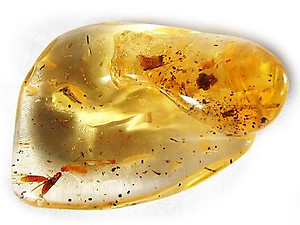Metaphysical guide of Copal, Physical properties of Copal
|
COPAL, AMBER
Copal is a type of resin produced from plant sap, often from members of the genus Copaifera. The term is particularly identified with the aromatic tree resins used by the cultures of pre-Columbian Mesoamerica as ceremonially burned incense and other purposes. More generally, the term copal describes subfossil resinous substances in an intermediate stage of polymerization and hardening between more "gummy" resins and amber. The word copal is derived from the Nahuatl language word copalli, meaning "incense".
Amber (or, technically, resinite) is fossilized tree resin (not sap), which has been appreciated for its color and natural beauty since Neolithic times. Amber is used as an ingredient in perfumes, as a healing agent in folk medicine, and as jewelry. There are five classes of amber, defined on the basis of their chemical constituents. Because it originates as a soft, sticky tree resin, amber sometimes contains animal and plant material as inclusions.
In very simple terms, in order to qualify a piece of resin as true Amber, a couple of things need to have happened. First, the molecules must have polymerized or formed a polymer (a compound where two or more molecules have joined together) and secondly, the specimen must be at least 100,000 years old.
Copal or Copalite is the term given to organic resins that are not old enough (ie YOUNGER than 100,000 years) to have fossilized and hardened sufficiently to become Amber. Amber is often imitated by plastics, colored glasses and some modern tree resins. True Ambers have a low specific gravity (amber can float on salt water) and inclusions can distinguish it from plastics and glasses. In Africa, Copal is found in the coastal countries of East and West Africa, but especially on Madagascar. This so-called Madagascar Amber is solidified resin of the Amber Pine but is only 1,000 - 10,000 years old. Most Amber from Columbia is less than 250 years old and in fact is not Amber at all, but the softer, younger version called Copal. Amber from the Baltics has been dated to average between 35-50 Million years old Amber from the Dominican Republic is up to 40 million years old. Dominican Amber differentiates itself from Baltic Amber by being mostly transparent and often containing a higher number of fossil inclusions. In summary, here are a few facts about Amber and Copal:
- Amber is defined by geologists as fossilized tree resin
- Amber is tree resin (not tree sap). Sap is the fluid that circulates through a plant`s vascular system. Sap to a tree, is like blood flowing through the veins of you or me. Resin, on the other hand, is a semi-solid amorphous (no crystal structure) organic substance that is secreted in pockets and canals through epithelial cells of the plant. It`s the really sticky stuff that after time will fossilize and harden.
- Hardened tree resin that is less than 100,000 years old is called Copal.
- Copal becomes Amber when it has finished fossilizing.
- Copal is still in the process of turning into a fossil.
- Copal can "craze" or crack on the surface as the volatile oils (or turpenes) evaporate.
- Copal will dissolve in acetone, but Amber will not.
- Copal from Madagascar and Columbia are 250 to 10,000 years old.
- Amber from the Baltic and the Dominican Republic are 25 to 40 million years old.
Physical properties of Amber:
Metaphysical guide of Amber:
Clearing, Healing, Protective
Chakra(s): All Astrological sign(s): Leo, Aquarius Vibration: Number 3 A powerful yet gentle healer and cleanser, Amber draws out and transmutes negative energy of all kinds on all levels. Amber aids in physical self-healing, emotional healing of depression, and environmental clearing. One of its most unique characteristics is that Amber never needs clearing. Amber opens and cleanses all of the Chakras.
Highly protective, Amber also aids in the manifestation of ideas to reality. The life force trapped within Amber promotes fertility, and its protective and environmental clearing properties make it a good stone to use to prepare a healing or birthing room. Use Amber with the Solar Plexus Chakra to increase confidence, mental clarity, and creative self-expression. Physically, Amber helps with the organs of elimination, including the liver, kidneys, bladder, and stomach. Amber can be used for kidney and bladder stones. Also a stone of the Throat Chakra, Amber can help with laryngitis and goiter. Back to Metaphysical and Physical Guide
|
The Copal products that may help you

